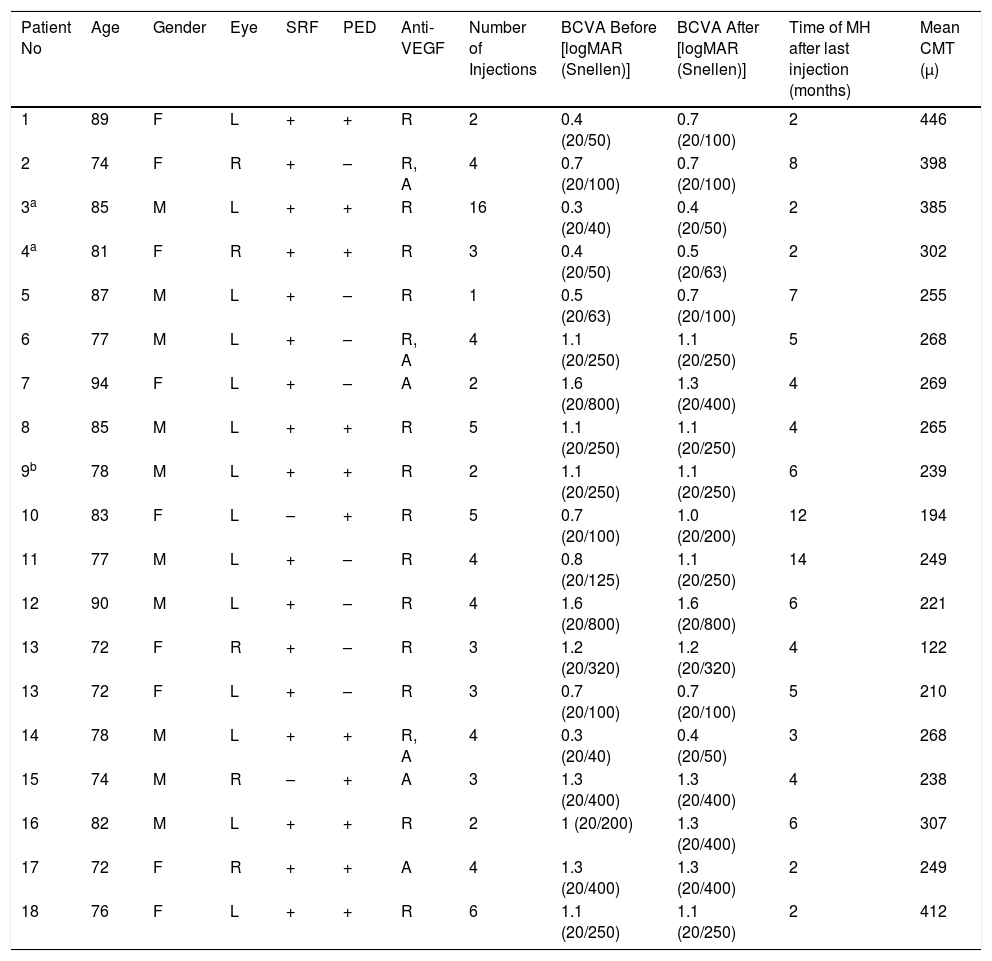Age-related macular degeneration (AMD) is the primary cause of blindness in developed countries, particularly in older adults. Anti-vascular endothelial growth factor (anti-VEGF) intravitreal injection is the current standard treatment for neovascular form of AMD. Studies reporting macular hole (MH) formation following anti-VEGF treatment are limited, and the exact pathogenesis is still under discussion.
With the present study, we aim to analyse the clinical features of eyes developing MH after anti-VEGF therapy for neovascular AMD.
Materials and MethodsPatients were treated with intravitreal anti-VEGF agents for at least one year and stable for at least six months. Best-corrected visual acuity (BCVA) and optical coherence tomography findings were evaluated.
ResultsNineteen eyes of 18 patients were included in this study. Patients had an average age of 77.7 years at first visit and eight were female. The average number of injections before the MH formation was four. MH developed after a mean follow-up of 5.1 months after the last injection. Sixteen eyes had (84.2%) had choroidal neovascular membrane without any abnormal vitreomacular traction. Eleven eyes (57.8%) had retinal pigment epithelium detachment (PED), two (10.5%) had an epiretinal membrane (ERM), and one (5.2%) had retinal pigment epithelium (RPE) tear. The mean first and last BCVA was 1.07±0.48 LogMAR (0.3–1.8) and 1.16±0.38 logMAR (0.4–1.8), respectively.
ConclusionsA macular hole can be observed in AMD patients receiving anti-VEGF therapy. Increased fibrovascular scar tissue due to subretinal fluid resolution, neovascular membrane contraction, and the presence of PED, RPE tear, and ERM may contribute to MH formation.
La degeneración macular vinculada a la edad (DMAE) es la causa primaria de ceguera en los países desarrollados, especialmente en adultos mayores. Actualmente, la inyección intravítrea del factor de crecimiento endotelial antivascular (VEGF, por sus siglas en inglés) es el tratamiento estándar para la forma neovascular de la DMAE. Existen pocos estudios que informen de la formación de un agujero macular (AM) después de un tratamiento anti-VEGF, y la patogénesis exacta de AM permanece en debate.
El presente estudio tiene por objetivo analizar las características clínicas de los ojos que desarrollan AM después de recibir terapia anti-VEGF para la DMAE neovascular.
Materiales y métodosLos pacientes fueron tratados con agentes anti-VEGF intravítreos durante al menos un año, permaneciendo estables durante al menos 6 meses. Se evaluaron la mejor agudeza visual corregida (MAVC) y los hallazgos de tomografía de coherencia óptica.
ResultadosSe incluyeron en el estudio 19 ojos de 18 pacientes. La edad media de los mismos fue de 77,7 años en la primera visita. Ocho pacientes eran de sexo femenino. El número medio de inyecciones antes de la formación de un AM fue de cuatro. El AM se desarrolló después de un seguimiento medio de 5,1 meses desde la última inyección. Dieciséis ojos (84,2%) exhibieron membrana coroidal neovascular sin tracción vitreomacular anormal. Once ojos (57,8%) exhibieron desprendimiento del epitelio pigmentario (DEP) de la retina, dos (10,5%) tuvieron membrana epirretinal (MER) y uno (5,2%) presentó desgarro del pigmento epitelial de la retina (PER). La media de la MAVC fue de 1,07±0,48 LogMAR (0,3−1,8) y 1,16±0,38 logMAR (0,4−1,8), respectivamente.
ConclusionesPuede observarse un agujero macular en pacientes de DMAE que reciben terapia anti-VEGF. El aumento del tejido cicatricial fibrovascular debido a la resolución del líquido subretinal, la contracción de la membrana neovascular y la presencia del DEP, el desgarro del EPR y la MER podrían contribuir a la formación de un AM.











